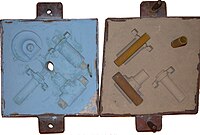
Photo from wikipedia
Abstract Fully coupled fluid-mechanical numerical analyses using a nonlinear constitutive model to analyze soil deformation and liquefaction caused by monotonic or cyclic loading are challenging and in increasing demand. The… Click to show full abstract
Abstract Fully coupled fluid-mechanical numerical analyses using a nonlinear constitutive model to analyze soil deformation and liquefaction caused by monotonic or cyclic loading are challenging and in increasing demand. The constitutive model performance impacts the quality of the analysis and its practice-friendliness influences the calibration cost. The Dafalias-Manzari 2004 (DM04) two-surface model is a critical-state compatible and state-parameter-related plasticity model developed in the framework of Bounding Surface theory, which has been widely implemented and studied. However, improvements in performance and practice-friendliness justify the need for a reformulation and practical extension of the DM04 model. In this work, by revising some formulas without adding too much complexity and retaining the general 3D formulation, improved performances are achieved with good matches between the simulated results and experimental data as well as empirical relationships with various initial and loading conditions. The new model which was implemented in FLAC3D has internally calibrated parameters for the standard cyclic resistance field (SCRF) sand, which is compatible to cyclic resistance charts and empirical relations. SCRF sand modeling has proved useful in numerical experiments, overcoming the disturbance issue encountered during sampling preparation in laboratories. A case study of recorded downhole array ground motions using this proposed model and procedures is presented.
Journal Title: Computers and Geotechnics
Year Published: 2021
Link to full text (if available)
Share on Social Media: Sign Up to like & get
recommendations!